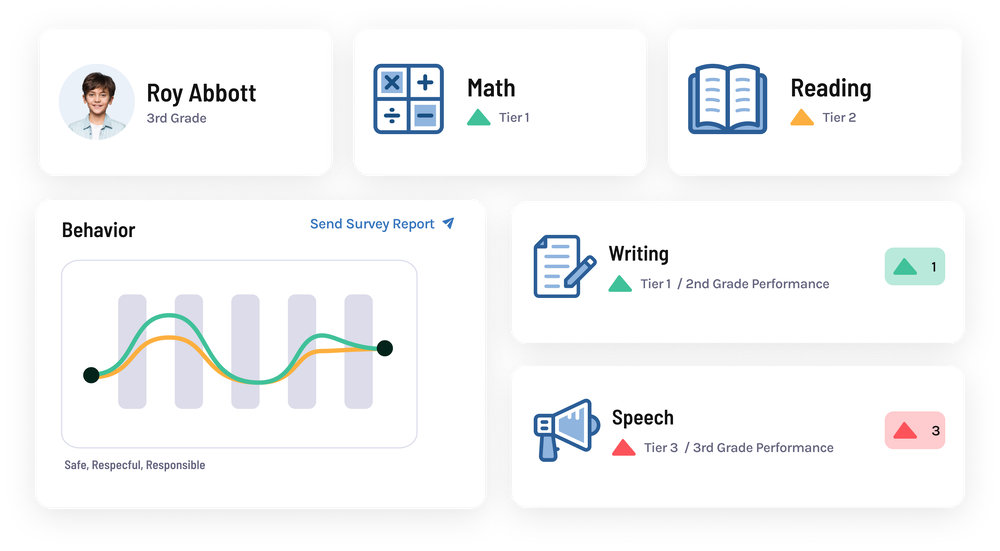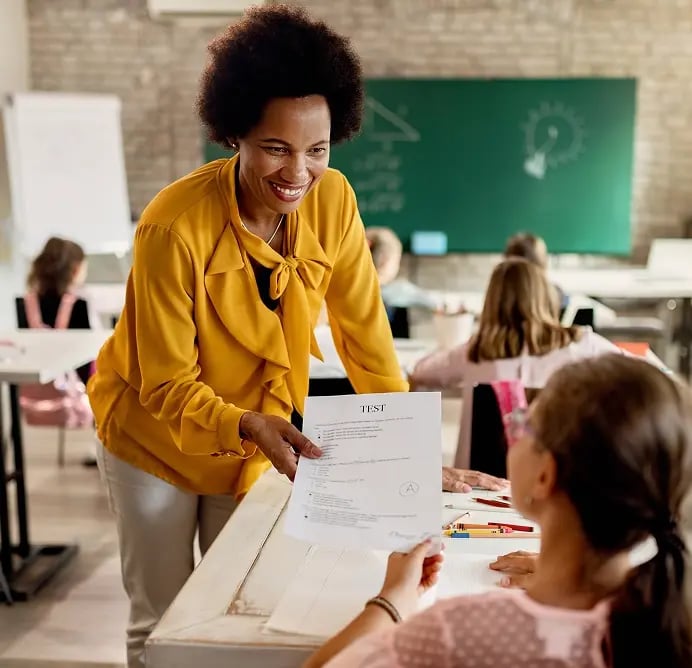Learning to read is one of the most important milestones in a child’s educational journey. Yet for many students, this process doesn’t come easily—and when early reading instruction falls short, it can affect learning for years to come.
The Science of Reading (SoR) provides a clear, research-based understanding of how the brain learns to read and what instructional approaches consistently lead to success. But understanding the science is only half the battle. Putting it into practice requires the right tools, data, and interventions to ensure every student receives the support they need to become a confident, capable reader.
Teaching Reading Key Takeaways
- Teach by the science. Effective reading instruction builds on five key pillars: phonemic awareness, phonics, fluency, vocabulary, and comprehension.
- Use data to drive support. MTSS helps educators identify needs, guide interventions, and track progress.
- Bridge research and practice. Aligning Science of Reading principles with MTSS ensures every student gets the right support to become a confident reader.
What Is the Science of Reading?
Dr. Louisa Moats, a leading researcher and co-developer of LETRS professional learning, defines the Science of Reading as:
...the emerging consensus from many related disciplines, based on literally thousands of studies, supported by hundreds of millions of research dollars, conducted across the world in many languages. These studies have revealed a great deal about how we learn to read, what goes wrong when students don’t learn, and what kind of instruction is most likely to work the best for the most students.
In other words, the Science of Reading is not a single program or philosophy—it’s a deep, interdisciplinary body of evidence that tells us what works, what doesn’t, and why.
Related Video: Science of Reading: Addressing Unbalanced Literacy
The Five Pillars of Reading
.png?width=800&height=600&name=5%20Pillars%20of%20Literacy%20(3).png)
Decades of research have identified five essential components that build the foundation for reading proficiency:
- Phonemic Awareness: Recognizing and manipulating the individual sounds (phonemes) in spoken words—understanding that words are made up of smaller sound units.
- Phonics: Connecting those sounds (phonemes) with the letters and letter patterns (graphemes) that represent them in written language.
- Fluency: Reading text smoothly, accurately, and with expression. Fluent readers can focus less on decoding and more on meaning.
- Vocabulary: Developing a rich understanding of words and their meanings, essential for both comprehension and communication.
- Reading Comprehension: The ultimate goal—being able to understand, interpret, and reflect on what is read.
When instruction explicitly and systematically addresses these five areas, students build the strong neural pathways necessary for lifelong literacy.
Related Resource: Foundational Reading Skills & MTSS
From Research to Practice: Bridging the Gap
Even educators familiar with the Science of Reading often face a key challenge: translating theory into effective classroom practice.
- What does explicit, systematic instruction look like day-to-day?
- How do we identify which students need which supports—and when?
- How do we ensure interventions are working?
This is where data, collaboration, and evidence-based resources become essential.
Using Data to Drive Literacy Support
Effective reading instruction doesn’t stop at whole-group lessons—it thrives when educators can pinpoint where a student is struggling and respond quickly. To do that, schools need timely, actionable data on foundational reading skills.
Within a Multi-Tiered System of Supports (MTSS), this means:
- Screening all students to identify who may need additional support.
- Progress monitoring to track whether interventions are effective.
- Team-based decision-making using consistent data across classrooms and grades.
Without a clear system for collecting and interpreting data, even strong instructional practices can fall short.
Related Webinar: Supporting Early Dyslexia within an MTSS Practice
Finding Evidence-Based Interventions That Work
Thousands of reading programs exist, but not all are grounded in the Science of Reading. Educators can rely on trusted sources to guide selection, such as:
- Florida Center for Reading Research (FCRR) – Free student center activities and teacher resources.
- Colorado Department of Education’s Evidence-Based Program List - Curated list of reading programs that align with SoR principles.
- What Works Clearinghouse - A national resource summarizing research on educational interventions.
When schools pair these resources with a data-driven platform like Branching Minds, teams can easily match the right interventions to the right students, monitor fidelity, and measure impact—all within one centralized system.
Putting It All Together: The MTSS Connection
The Science of Reading and MTSS share a common purpose: ensuring that every student gets the instruction and support they need to succeed.
By combining systematic, explicit instruction with structured support systems, schools can move from reacting to reading struggles to preventing them.
This means:
- Using screening and diagnostic data to inform instruction.
- Implementing targeted interventions for Tier 2 and Tier 3 students.
- Monitoring progress regularly to ensure growth.
When these practices are in place, literacy instruction becomes more accessible, consistent, and effective across classrooms.
Related Resource: How MTSS Connects with the Science of Reading
Next Steps for School Leaders and Teams
For principals, MTSS coordinators, and teachers looking to strengthen literacy practices:
- Review your current curriculum and interventions. Do they align with SoR principles and cover all five pillars of reading?
- Ensure instruction is systematic and explicit. Students benefit most from clear, intentional teaching sequences that build on prior skills.
- Leverage your MTSS platform. Tools like Branching Minds make it easier to see which interventions are working and where additional support is needed.
- Invest in professional learning. High-quality PD—such as LETRS or webinars focused on foundational reading skills—empowers teachers to bring research to life in their classrooms.
Related Resource: Free Editable Template for Literacy Professional Learning
Literacy and MTSS Resources
Explore these resources from Branching Minds and our partners to deepen your understanding of effective literacy instruction:
- Webinar: K-4 Literacy and MTSS: A Success Story With Orange County Schools
- Blog: 3 Tips for an Effective Secondary School Literacy Plan
- Podcast: Reading SOS: What About Secondary Students Who Can't Read?
How MTSS and the Science of Reading Work Together
Teaching reading effectively isn’t about following a trend—it’s about following the science. When educators combine evidence-based instruction, collaborative problem-solving, and the right tools, every student has the opportunity to become a confident, lifelong reader.

About the author
Dr. Essie Sutton
Essie Sutton is an Applied Developmental Psychologist and the Director of Learning Science at Branching Minds. Her work brings together the fields of Child Development and Education Psychology to improve learning and development for all students. Dr. Sutton is responsible for studying the impacts of the Branching Minds on students’ academic, behavioral, and social-emotional outcomes. She also leverages MTSS research and best practices to develop and improve the Branching Minds platform.

Reading Achievement Starts With a Strong MTSS Foundation
For each important aspect of early literacy growth in MTSS, Branching Minds makes the work more practical and sustainable.













.png?width=1436&height=956&name=Understanding%20Literacy%20Basics%20(Preview).png)

.png?width=716&height=522&name=Addressing%20Foundational%20Reading%20Skills%20in%20MTSS%20(preview).png)

.png?width=716&height=522&name=Qualitative%20data%20MTSS%20(preview).png)